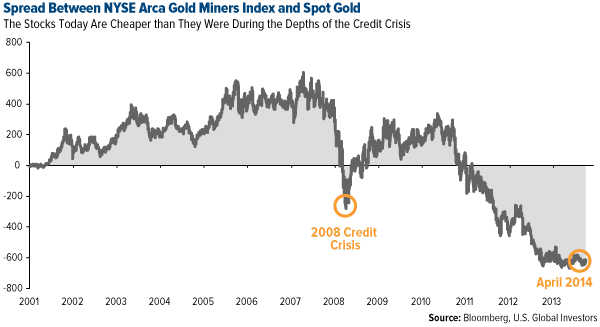Gold Market Radar (June 9, 2014)
For the week, spot gold closed at $1,253.25, up $3.52 per ounce, or 0.28 percent. Gold stocks, as measured by the NYSE Arca Gold Miners Index, gained 0.73 percent. The U.S. Trade-Weighted Dollar Index rose 0.04 percent for the week.
Strengths
- Gold rose $9.77 per ounce on Thursday after the European Central Bank (ECB) cut its deposit rate to 0.1 percent. The ECB became the first major central bank to take one of its main rates negative, as President Mario Draghi unveiled historic measures to fight deflation. By cutting the deposit rate to 0.1 percent, the central bank will effectively charge banks for holding money overnight. The bank also cut its main refinancing rate to 0.15 percent. Dennis Gartman, author of The Gartman Letter, said "the ECB's policy changes were very expansionary and that on-balance is supportive of gold…I think more is coming."
- The gold price declined on Friday morning after U.S. employment data was released, but recovered intraday, closing unchanged. U.S. employers added 217,000 jobs in May after a 282,000 gain in April. The median Bloomberg forecast called for a gain of 215,000 jobs in May.
- China and India (Chindia) are consuming more gold than the global production, according to Bloomberg’s Ken Hoffman. His research shows that China is consuming gold at a rate of 5.15 million ounces per month, while India, at the current import-tariff reduced rate, is consuming 2.85 million ounces per month. The total Chindia consumption is 8 million ounces per month, or 560,000 ounces higher than the estimated 7.44 million ounce per month global-mine output. With this deficit in mind, any relaxation of Indian import curbs will likely skew the fundamental supply-demand balance even further into deficit.
- The merger and acquisition (M&A) front got a new hit this week as B2Gold signed a merger-implementation agreement with Mali-focused Papillon Resources. The deal, valued at around $570 million, gives B2Gold one of the better assets in West Africa with 4.2 million ounces in the measured and indicated category, at 2.4 grams per tonne. In other news, Centerra Gold will begin shutting down its Kumtor mine in Kyrgyzstan unless the government grants necessary approvals to continue mining. Kumtor’s revenue represents about 5 percent of the whole Kyrgyz economy. It is positive that this company takes a stand against a government that continuously moves the goal posts for a critical industry.
Weaknesses
- The U.S. Mint’s gold coin sales slumped in May, reaching a total of 35,500 ounces, 7.9 percent lower than the preceding month. The report reinforces the expectations for weak seasonal demand as we head into the summer. On a positive note, the Mint reported silver coin sales rose 12 percent from April and 15 percent from a year earlier.
- PwC, in its latest Mine Report published Thursday, says “2013 was a year that forced the global mining industry to realign expectations in one of the most difficult operating environments for years.” Gold’s greatest decline in three decades, coupled with record impairments of $57 billion last year, saw global mining profits plunged 72 percent to a decade low of $20 billion in 2013. Gold miners lost $110 billion off market capitalization, while gold reserves fell 8 percent in 2013, to 431 million ounces.
- No settlement has been reached in the platinum-sector strike in South Africa, nearing its nineteenth week. The stoppage has cost producers an estimated $1.9 billion in revenue, as the strike becomes the longest and costliest strike in the African nation. As a result, the mining sector contribution to the economy declined the most in 47 years, resulting in the first contraction of GDP since 2009.
Opportunities
- While its commodities analysts bash gold, calling it a “slam-dunk” sell, Goldman Sachs is actually buying gold. The bank has agreed to swap dollars for gold with the government of Ecuador, a total 466,000 ounces (or $580 million), at an estimated price of $1,245 per ounce for a three-year term. Even though the Ecuadorian side denied that the transaction was a sale, it is highly unlikely the South American government will have the means to recover its gold in three years. This is especially possible since Ecuador’s use of the dollar as official currency means it can’t finance its deficits by printing money. Actions speak louder than words, and Goldman is buying gold.
- RBC Capital Markets initiated coverage of Klondex Mines with a $3.00 price target and a buy rating. According to analyst Sam Crittenden, Klondex is uniquely positioned to create value with two high-grade gold deposits in Nevada. Klondex owns the Midas Mill and has very modest capital requirements going forward. Crittenden argues that the shares are not pricing the outstanding 41 gram per tonne grade of the company’s reserves. It also seems that it is not pricing the strategic value of its properties and mill, or the motivated and experienced team.
- Sentry Investments wants Mexico-focused producer Timmins Gold to remake its board of directors, citing displeasure with the current management and board. Sentry, who owns about 17 percent of Timmins, proposed a slate of six directors to the eight-member board as it seeks to draw M&A attention to the miner. In other news, Detour Gold reported high-grade drill results from its regional exploration at Detour Lake, which outlines the potential for blending higher grade ore to its processing facility.
Threats
- Gold prices are set to decline below $1,000 per ounce by 2016, according to a recent report by Societe Generale. The French bank believes the Federal Reserve is likely to hike rates at a much faster pace than currently discounted by the market. As such, bullion prices will trade below $1,200 next year and below $1,000 in 2016. In addition to selling gold, the bank also recommends selling silver due to high physical ETF holdings, as well as copper due to the Chinese slowdown.
- The Philippines government expects to double its annual returns from mining under a new revenue-sharing scheme approved this week. The scheme aims to retain as much as 55 percent of the industry’s net revenues, or 10 percent of gross revenue, whichever is higher. In a similar move, the Tanzanian government, Africa’s fourth-largest gold producer, is reviewing mining contracts to ensure the government earns a larger share of revenues.
- Newmont Mining has stopped output at its Batu Hijau mine in Indonesia, stating that its concentrate storage facilities are now full following the raw minerals export ban introduced by the Asian nation earlier in the year. The company will continue to sell copper concentrate from storage to PT Smelting, Indonesia's only copper smelter. However, the smelter does not have enough capacity to buy all of Batu Hijau's production.

















